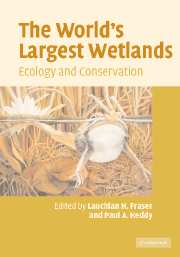Book contents
- Frontmatter
- Contents
- List of contributors
- Preface
- 1 Introduction: big is beautiful
- 2 The West Siberian Lowland
- 3 The Amazon River basin
- 4 The Hudson Bay Lowland
- 5 The Congo River basin
- 6 The Mackenzie River basin
- 7 The Pantanal
- 8 The Mississippi River alluvial plain
- 9 The Lake Chad basin
- 10 The River Nile basin
- 11 The prairie potholes of North America
- 12 The Magellanic moorland
- 13 The future of large wetlands: a global perspective
- Index
11 - The prairie potholes of North America
Published online by Cambridge University Press: 10 August 2009
- Frontmatter
- Contents
- List of contributors
- Preface
- 1 Introduction: big is beautiful
- 2 The West Siberian Lowland
- 3 The Amazon River basin
- 4 The Hudson Bay Lowland
- 5 The Congo River basin
- 6 The Mackenzie River basin
- 7 The Pantanal
- 8 The Mississippi River alluvial plain
- 9 The Lake Chad basin
- 10 The River Nile basin
- 11 The prairie potholes of North America
- 12 The Magellanic moorland
- 13 The future of large wetlands: a global perspective
- Index
Summary
Introduction
Prairie potholes or sloughs are small, shallow, palustrine wetlands, common in north-Central North America, with vegetation that is usually herbaceous (Fig. 11.1). In the Aspen Parkland in Canada, which is the transition zone between the prairies and the boreal forest, aspen (Populus spp.), willows (Salix spp.), and other tree species are often found around the periphery of potholes. The suppression of fire has resulted in tree and shrub invasion of prairie-pothole basins throughout much of the region. Their primary sources of water are precipitation and groundwater. Most do not have surface inflows or outflows, except during exceptionally wet years when they fill up and surface-water flows temporarily connect them. In most years, water leaves prairie potholes primarily by evapotranspiration and groundwater recharge. During droughts, there is often no standing water in them at all. Their catchments are typically very small and this, combined with significant changes in seasonal and annual precipitation, results in rapid and large changes in water levels within and among years. These water-level changes can result in changes in the species composition and ecosystem functions of these wetlands from year to year, especially in deeper potholes. In other words, prairie potholes are very dynamic, shallow depressional wetlands in which plant and animal populations are constantly adjusting their distribution and population size to changing water levels. Although no single prairie pothole would ever qualify as one of the world's largest wetlands, collectively they are one of the largest and most-important wetland complexes on the planet.
- Type
- Chapter
- Information
- The World's Largest WetlandsEcology and Conservation, pp. 393 - 423Publisher: Cambridge University PressPrint publication year: 2005



